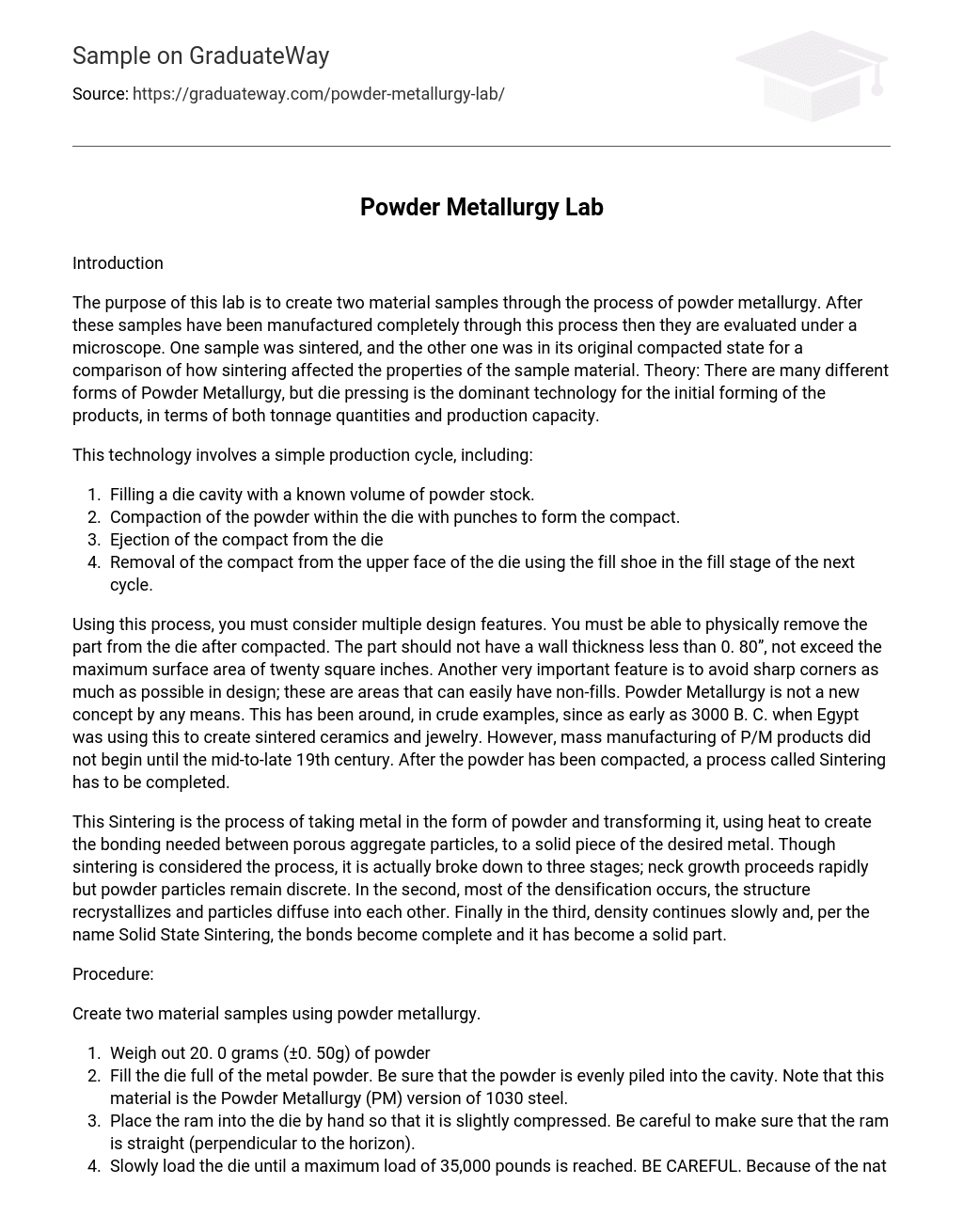Introduction
The purpose of this lab is to create two material samples through the process of powder metallurgy. After these samples have been manufactured completely through this process then they are evaluated under a microscope. One sample was sintered, and the other one was in its original compacted state for a comparison of how sintering affected the properties of the sample material. Theory: There are many different forms of Powder Metallurgy, but die pressing is the dominant technology for the initial forming of the products, in terms of both tonnage quantities and production capacity.
This technology involves a simple production cycle, including:
- Filling a die cavity with a known volume of powder stock.
- Compaction of the powder within the die with punches to form the compact.
- Ejection of the compact from the die
- Removal of the compact from the upper face of the die using the fill shoe in the fill stage of the next cycle.
Using this process, you must consider multiple design features. You must be able to physically remove the part from the die after compacted. The part should not have a wall thickness less than 0. 80”, not exceed the maximum surface area of twenty square inches. Another very important feature is to avoid sharp corners as much as possible in design; these are areas that can easily have non-fills. Powder Metallurgy is not a new concept by any means. This has been around, in crude examples, since as early as 3000 B. C. when Egypt was using this to create sintered ceramics and jewelry. However, mass manufacturing of P/M products did not begin until the mid-to-late 19th century. After the powder has been compacted, a process called Sintering has to be completed.
This Sintering is the process of taking metal in the form of powder and transforming it, using heat to create the bonding needed between porous aggregate particles, to a solid piece of the desired metal. Though sintering is considered the process, it is actually broke down to three stages; neck growth proceeds rapidly but powder particles remain discrete. In the second, most of the densification occurs, the structure recrystallizes and particles diffuse into each other. Finally in the third, density continues slowly and, per the name Solid State Sintering, the bonds become complete and it has become a solid part.
Procedure:
Create two material samples using powder metallurgy.
- Weigh out 20. 0 grams (±0. 50g) of powder
- Fill the die full of the metal powder. Be sure that the powder is evenly piled into the cavity. Note that this material is the Powder Metallurgy (PM) version of 1030 steel.
- Place the ram into the die by hand so that it is slightly compressed. Be careful to make sure that the ram is straight (perpendicular to the horizon).
- Slowly load the die until a maximum load of 35,000 pounds is reached. BE CAREFUL. Because of the nature of the tensile tester, once full compaction is achieved, the load will increase incredibly fast. This can buckle the ram (among other damage).
- Release the load.
- Remove the sample by putting the special WEB (wooden ejection blocks) on top of the die and slowly applying a slight load to the blocks.
- Each lab group will repeat this process, making two blocks each. Measure the three dimensions of each sample with calipers. Confirm that the dimensions are uniform.
- Break one sample in half, by hand. Save the piece for part two of this lab. Place the second complete sample in to the sintering oven. Be sure to lightly touch the graphite sleeve. This sample will be sintered for 30 minutes at 2050°F.
- Unless you are able to break the sintered sample in half, cut a small (approximately ? ” length) section of it on the wet cutoff machine.
- Mount both, the sintered and the non-sintered, samples together in one mount.
- Heat for a minimum of 10 minutes in the press.
- Remove the mount from the press and cool in a beaker of water.
- Quickly sand flat, both the top and bottom corners, of the mount on the electric sander.
- Sand the mount with each of the given sanding papers, sand for 5 minutes each paper.
- Evaluate the samples, both sintered and non-sintered, under microscope.
Conclusion
By calculating the density and observing the solubility of the unknown liquid, it was determined that the identity of the liquid was Cyclohexane. The density found during the experiment was calculated to be 0. 74g/mL and the liquid was only soluble in ethanol (formed a homogenous mixture).
Therefore the closest liquid on the comparison chart was Cyclohexane. The percent error of the density calculated during this experiment to the accepted value was 5. 13%. Additionally, through determining the solubility and melting point of the unknown solid, it was determined that the solid was Lauric Acid. The solubility test conducted found heterogeneous mixture in water and a homogeneous mixture in ethanol. The melting point was determined to be 43°C. The solid with the closest physical properties to those was determined to be Lauric Acid. The percent error for the melting point was determined to 2. 33%.





